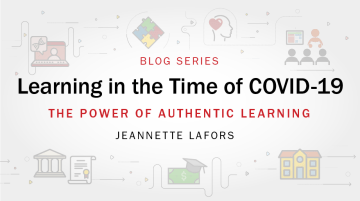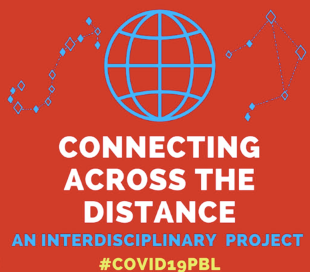Beyond the Bell: The Power of Authentic Learning

By Jeannette LaFors
This post is part of LPI's Learning in the Time of COVID-19 blog series, which explores evidence-based and equity-focused strategies and investments to address the current crisis and build long-term systems capacity.
COVID-19 turned the world upside down, but students have been demonstrating through authentic projects and presentations of learning that they remain hungry for and capable of doing rigorous, meaningful work. In the process, they made surprising discoveries about themselves and topics of interest through course adaptations during the final months of the 2019–20 school year.
To understand how students and staff responded to the challenges of COVID-19, the Learning Policy Institute connected this spring with nearly 40 students through interviews and/or live presentations of their learning. We also spoke with teachers, principals, and district staff, most of whom are involved in the California Performance Assessment Collaborative (CPAC), a professional learning community dedicated to the advancement of meaningful assessments for California students. As students and educators described how they have navigated uncharted territory, they shared both compelling and inspiring experiences that can inform pathways forward in education.
Personalization and Student Autonomy
As the pandemic unfolded in their communities and across the globe, many educators took a step back from planned lessons, contemplated the personal needs of their students and families, and considered how best they might pause, adapt, and connect their instruction with current realities.
COVID-19 hit as middle school students from the School for Examining Essential Questions of Sustainability (SEEQS) in Honolulu, HI, were embarking on self-directed projects as part of their yearlong interdisciplinary exploration of sustainability. The students had more autonomy to design and implement their projects at home while sheltering in place, and many students connected their work to the emotional, physical, and economic threats of COVID-19. Projects included rain catchers and irrigation systems to sustain home gardens, developing a Twitter bot to remind people to wash their hands to prevent COVID-19 infection, creating sidewalk art, and researching and engaging in healthy activities to alleviate stress. You can “tour” the school’s virtual exhibition room by room as members of the SEEQS community did before the end of the school year. (For best results, view in “present” mode.)
In many cases, teachers required less synchronous “face-to-face” time for students, some of whom had to work to support their families or assume additional responsibilities such as child care. Another corresponding shift was to rethink project requirements to reflect the new reality. In a typical year, for example, 10th-graders at Impact Academy in Hayward, CA, would have presented three academic artifacts as evidence of their readiness to advance to the “upper division” (grades 11 and 12). Because COVID-19 altered the conditions for teaching and learning, teachers allowed for one academic artifact and an example from personal experience that could demonstrate growth and/or proficiency aligned to expected learning.
Tenth-grader Daniel Shiva seized this opportunity to describe skills and insights he gained through his self-determined quest to learn to cook. He explained why it was a valuable pursuit and documented how his cooking skills grew as he advanced from simple dishes (mac ’n’ cheese) to more complex recipes (chicken piccata). He also reflected on the knowledge, skills, and confidence he gained while building his culinary repertoire. Daniel’s reflections about what he learned and how he grew—both as a person and as a learner—underscore the value of providing multiple ways for students to express their personalities, energy, and spark.
Innovation and Adaptation
Across the country, the pandemic crisis has brought about innovation, adaptation, and creativity in teaching and learning, allowing educators to broaden the ways in which they engage students and assess their academic talent. Student defenses, in which students not only present the results of an area of study, but often share their reflections on what they have learned about themselves as learners, are a spring tradition for many CPAC member schools. Last spring, students who would have normally presented in-person “defenses of learning” adapted to new ways of demonstrating their readiness to graduate or move on to the next step in their academic career.
Matt Dimond, a student at Oceana High School in Pacifica, CA, said that after working for 4 years toward his culminating senior project presentation, he was determined to “do everything I could to present if given the opportunity.” On the day of his presentation, Matt responded to a controversial question, “Should the Green New Deal (proposed to the U.S. Congress) be implemented?” with a nuanced argument based on extensive research. His audience included his mentor, his mother, and a classmate. “I was really proud of myself for doing it,” he reflected. “I think our senior project prepares you for a lot of things in college, like how to research, analyze, write, and present.”
Ellie Stokes, a student at Ruth Asawa School of the Arts in San Francisco, CA, set out to create live events featuring and promoting young and local artists and musicians for her senior project. Her first “Big Leap Collective” in-person event in February was a terrific success, and she was deep into the details of organizing her second event when COVID-19 caused things “to come to a crashing halt.” After experimenting with different formats, Ellie eventually succeeded with livestreaming events through Instagram. A musician herself, Ellie found solace in her creative endeavors and inspiration from her fellow students, noting, “Seeing everyone pursue their own project is inspiring!”
Agents of Change
Many projects became even more relevant to students as they witnessed the compounding negative effects of COVID-19 on the issues they were addressing in their work.
Ricardo Herrera, for example, a 12th-grader at Washington Heights Expeditionary Learning School (WHEELS) in New York City, NY, had been engaged in the interdisciplinary study of environmental justice and was a member of the Green Air Corridor Project pressing for greening efforts in his community. Ricardo and his classmates spoke out on national television, through op-eds, and at local community board meetings against environmental factors negatively impacting their predominantly low-income and Latino/a community. After COVID-19 hit, they investigated how race, class, and power shaped the outbreak and response, noting air pollution and respiratory illness are factors that can contribute to higher rates of COVID-19-related deaths. During a nationwide exhibition of learning (see box), Ricardo shared, “It is more important than ever to raise our voices. Low-income communities are more vulnerable to COVID-19 because the air quality does not meet [safety] standards. I know that people are depending on me to complete this project. COVID-19 will not stop me.”
|
|
The national “Connecting Across the Distance” exhibition on May 29 was born out of an open invitation by Joe Truss, Principal of Visitacion Valley Middle School in San Francisco, for educators to engage their students in meaningful anti-racist projects related to COVID-19. Read his blog post with The Education Trust >> |
Tenth-grade students in the Green Energy Pathway at Skyline High School in Oakland, CA, persisted through challenges with distance learning, including internet connectivity issues and distractions at home. Like Ricardo, they were compelled by the importance of their work. From January to May, students responded to the driving question, “How can schools be more resilient and designed to protect those most vulnerable to climate change?” With support from their teacher and Youth-Plan Learn Act Now! (Y-PLAN) program staff, they prepared for the opportunity to present their research and recommendations to local and state policymakers and influencers. The students began their project in January, conducted research in February, formulated recommendations in March, and presented in May.
When Skyline teacher Terri Van Hare asked her students which climate threat was of greatest concern, several students pointed to air quality and excessively high temperatures. One student emphasized, “Air quality really impacts learning.”
Across the Bay in San Francisco, Geri Urgel, a 12th-grader graduating from the Public Service Pathway program at O’Connell High School, identified a critical need for financial support among college-bound undocumented students. This pressing issue became the focus of her senior Youth-Led Participatory Action Research (YPAR) project. She explained: “I am an immigrant myself and I know it’s hard to find … financial support to graduate from college. That motivated me to do the research.” Geri also secured $15,000 in grants from community organizations to provide scholarships to several students and formed a scholarship selection committee responsible for evaluating applications. A month after graduation, Geri was still devoted to her action project, informing scholarship recipients of their awards and gathering resources to support additional students in need.
Powerful Learning in a Virtual Setting
These examples of student learning demonstrate how young people think critically, problem-solve creatively, collaborate, manage, communicate, and reflect. In interviews, many of the students described wanting “to use their talent for good” as they dedicated significant time and energy to personally meaningful endeavors. The students teach us that their innate curiosity and their desire to connect with others, find joy, and be positive agents of change are powerful drivers for engagement and achievement—even in uncertain and difficult times.
These “beyond the bell” learning experiences—and others across the globe—model ways for us to reimagine teaching and learning for both the near- and long-term future. Students, with regular guidance and support from their teachers, created or advanced compelling projects and shined brilliantly as they presented their work to an authentic live audience.
Jeannette LaFors is an independent consultant supporting LPI’s work on the California Performance Assessment Collaborative.

